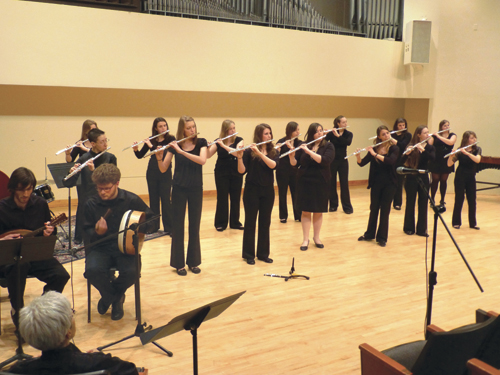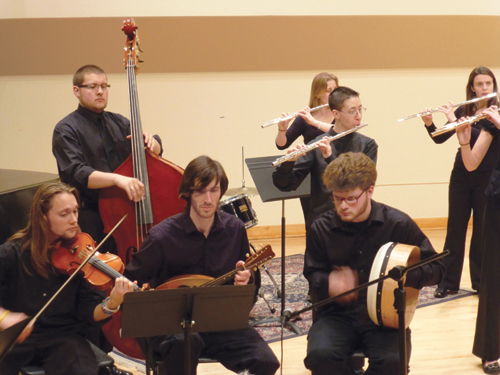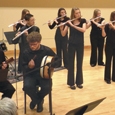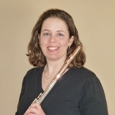
I first heard the Slippery Rock University Flute Choir perform Irish tunes at the 2006 NFA convention in Pittsburgh. They also perform this music each year at their spring flute choir concert. Their performances are filled with enthusiasm and energy and also serve to stretch their musical skills and creativity.
Stacey Steele, director of the Slippery Rock University Flute Choir and assistant professor of music at the school shares how she guides the students to perform in a style that seems so different from the traditional flute choir music that comprises the rest of the program.
What led you to bring Irish flute into your flute choir curriculum?
Several years ago, I heard a group of high school students from Ohio perform a concert of Irish tunes at the Campbell Pottery Shop near Edinboro, Pennsylvania. They were mostly string players, but a few other students were included, such as an oboist. Each student in the group was also a member of their high school orchestra, playing traditional literature. It was the best of both worlds for these students. They maintained a busy schedule playing gigs and were clearly very disciplined, all the while having a great time with their friends. Musically and artistically, they were impressive. The flawless hour-long program was in two sets, and every note they played was memorized.
My sister-in-law is from Dublin, and my initial interest in this type of music perhaps came from her stories of her small family home or the homes of friends often being filled with traditional music (sometimes called Trad) as entertainment, sometimes including traditional dances up and down their narrow hallway. Her son, my nephew, John Fetter, who is on the faculty at Eastman, wrote his dissertation on alternative styles in music education including identity development and curriculum design. I became fascinated with the concept of engaging students by enlarging the scope of traditional American music education.
Where did you find the tunes to use with your flute choir?
After hearing that high school group perform, I wanted to venture into this realm of music with my flute choir. I spoke to the director of the high school group and asked where he found the tunes they played. He explained that there were no arrangements for what he did, and there was also no specific source. He found the tunes from a myriad of places and went from there to arrange them for his own ensemble. I began buying books from reputable sources, including a few Irish sites online and just dove in. I played through dozens of tunes and chose three that with easy key transitions and varied tempos to introduce the music to our flute choir. Over the years I have discovered many resources, some that I have bought in Ireland, and others that are readily available here, such as O’Neill’s Music of Ireland arranged by James O’Neill.
How do you use to teach the tunes to your students?
The best and only authentic way to learn an Irish tune is to play it by ear. I have witnessed young children sitting in a pub next to their older relatives, picking up the tunes little by little until they have learned them. That is the tradition. Sometimes they learn the tunes phrase by phrase, as I play each section and they echo it back. That method feels uncomfortable to students who prefer learning from the printed page, but it is a valuable skill for them to develop. Other times I do give them printed music, and they memorize it on their own. Memorization, however, is always mandatory.
What do your students think about learning Irish flute techniques?
It has become a tradition to include Irish tunes on the spring concert, but I only want those students who are eager to try it to take part. Usually, that is everyone, but sometimes it is not. I let that be. The students in the flute choir all have differing abilities on flute, including some who are not music majors. This music also works well for students at all different playing levels. In Ireland, as I mentioned before, a seven-year-old might play along with older relatives and neighbors. Every-one can participate.
What part does improvisation play?
The entire flute choir plays the basic tune, and any student who wants to try to improvise may do so. It has been my experience that only those who know they are capable of succeeding offer to take an improvised solo. Some of the ways in which improvisation may be added to a tune are simple and quite similar to Baroque ornamentation. The students are free to use it as much or as little as they choose.
If a student is interested in playing a solo, I work with them on a few simply ways in which to ornament the tune. There are many books that serve as an easy guide to teaching traditional ornamentation, such as The Essential Guide to Irish Flute and Tin Whistle by Grey Larsen and The Complete Irish Flute Book by Mizzy McCaskill and Donna Gilliam. However, folk music in its truest form is an aural tradition learned when you are young. For adults who learn to ornament a tune by reading about it in a book, it can seem quite difficult. A few years ago, I had a student whose family played Irish music, so it was already in her ear and improvisation was second nature to her.
During a sabbatical in July 2007, soon after I began using Irish music with my flute choir, I attended the Willy Clancy Irish Music School on the west coast of Ireland. I signed up to take a class on penny whistle instead of Irish flute. When I arrived they asked me how many tunes I knew, and when I answered three, I was put in a class with a group of nine-year-olds despite my many years as a professional musician. Luckily, the teacher was happy to answer my many questions, and I learned many new tunes and the process of adding ornamentation.
What percussion instruments do use with the Irish flute music?
The only percussion instrument we use is the Irish bodhran. I have also used bass, mandolin, violin and guitar. I supply the bodhran and am always able to find a percussion student eager to learn how to play it. It is usually not an instrument they have had prior experience with.

What skills should flutists have before working on Irish flute choir music?
At the college level, all they need is enthusiasm and desire. The music is never too difficult for them if they are willing to spend the time memorizing it. In 2006, I was the director for the NFA High School Flute Choir, and we used a medley of Irish tunes for their performance. They came to the first rehearsal with the music memorized, and I supplied the accompanying instruments with students from my university.
How can directors incorporate Irish flute into their programs?
I have found that it works best for us to choose a medley of three tunes in a variety of tempos that are in the same key. Typically, they are written in AABB form. Play each tune in unison as many times through as you would like before going on to the next one. End each tune by holding the last note followed by an eight-measure intro by the rhythm section, which serves to set up the tempo of the new tune. After experimenting with a variety of possibilities, let the students know, or have them decide, what you are going to do on the concert, such as repeating the entire tune three times on each tune.
Being classically trained, it took me a long time to accept that there is no right way to determine how to play this music. I usually decide how many times we will play a tune based on how many students wanted to solo, and how many minutes I have for it in the program. If you have only one student who wants to play a solo on a particular tune, assign them an AABB section to play alone with the rhythm section. The entire group will come back in when the solo section is finished. If more than one student wants to solo on the same tune, just keep playing and adding more AABB sections, so they each get a turn.
When I first started using Irish music in my flute choir concerts, I was worried about doing something wrong. I kept asking questions of those whom I thought might know the rules. The response was usually just a confused look. Other than knowing what the style of the tune is – an air, a jig, etc., and interpreting it accordingly, just have fun and explore.






